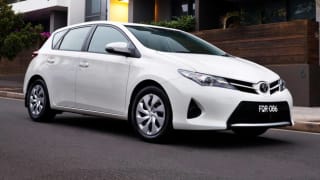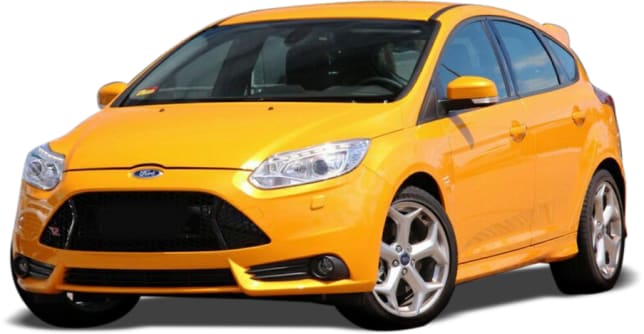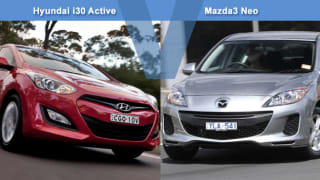There's a lot of competition for sub-$40,000 wallets in the small cars class. The Mazda3 is leading - and gaining more ground - with around 29,000 sales giving it close to 19 per cent of the market this year, with a big gap to the Holden Cruze's 23,000 and 15 per cent. Ford's Focus is seventh with 9000 and 5.5 per cent, but is trying hard to regain the attention it once used to have.
Value
The Ford Focus hatch has an entry level of $21,990 but asks $26,790 for the petrol engine and dual-clutch 'Powershift' auto transmission tested here in Trend spec, which lifts you to 16-in alloys (the base model has steel), front fog lights, rear parking sensors, cruise control, Bluetooth and voice control.
The Hyundai i30 SLX is $900 cheaper, but while it won the Carsguide COTY gong a few years ago, its 2.0-litre engine offers less power and torque, and features like the four-speed auto will make it start to look outdated among the competition.
Holden's Cruze CDX 1.8 is $300 less at $26,490. Its smaller engine also delivers less power and torque but uses more fuel, albeit 91RON rather than the more expensive 95RON Ford recommends for the Focus. The Cruze has similar safety features, and adds leather heated seats, but not Bluetooth - a feature that should be standard at this price.
The Toyota Corolla Levin SX hatch is $200 more than the Focus, and like the Cruze, has a 1.8-litre engine that delivers less power and torque while using more litres of the 91RON.
The class benchmark is the VW Golf, which you can in 90TSI from from $700 more with a great little turbo engine and twin-clutch transmission that combine for better economy and sparkling response, but it has staid style, smaller 15-in wheels - which don't hamper its dynamics - standard manual aircon and space-saver spare.
Mazda3 Maxx Sport hatch is $1570 more and has one less gear and a thirstier 2.0 litre engine, but on 91RON delivers similar power to the Cruze and Corolla - around 20 per cent less than the Focus. But the Mazda also adds satnav, six-stacker CD player and dual-zone climate control aircon among its extra features.
Design
The new Focus hatch needs to stand out on the street - and it does, looking like a Fiesta on steroids with funky body styling, hints of sport kit around the front fascia, and a pronounced rear spoiler.
But the interior takes it a bit too far, with a lot of visual buzziness stretching from the cluttered centre stack across the driver's cockpit area. The blue-lit instruments look great, but there seem to be more buttons and controls than anybody would ever need.
Safety
The new Focus has earned a five star ANCAP rating, and ticks all the boxes for safety. A battalion of 10 airbags is joined by stability and traction controls, front seatbelt pre-tensioners, hill start assist, and anti-lock brakes with brake force distribution to compensate for uneven loads and brake assist for panic stops.
Technology
The Trend hatch tested here carries Ford's 2.0-litre engine with common-rail fuel injection, developing 125kW of power and 202Nm of torque, and with the choices of either the six-speed dual-clutch sports automatic version we drove, or the five-speed manual (which drops the price $2300 to $24,490).
The auto is the more economical of the two, with official thirst of 6.6L/100km to the manual's 7.2L - both of them on the more expensive 95RON fuel. But while most sports transmissions use a side-gate for you to then row the shifter back and forth for 'manumatic' changes, the Focus instead has a little button on the knob that you toggle up and down with your thumb - a technique that's fiddly and unsatisfying.
Driving
The Focus is composed and predictable on the road, with its good grip, accurate steering and comfortable ride clearly the car's main highlights. With well-damped suspension and steering, you hear, rather than feel, the bumps. However, the rubber and road don't meet quietly, and there's tyre noise over all but the smoothest surfaces.
It's easy to manoeuvre in most parking situations, but it's got an oddly poor turning circle for something this small, and that shows in tighter city spots. Despite the sport aspirations of having a twin-clutch transmission, the system is clearly geared for economy rather than performance.
Unless you're manually controlling the gear selection with the button, the transmission changes up very quickly in normal mode. That will keep the thirst down a bit, but it can be annoying when it keeps jumping the gun well before you'd want it to. But we applaud the 'grade logic control' set-up that gives you extra engine braking to control descents, which means it doesn't run away when you're heading down a slope. Tap the brakes, and the transmission changes down and reins you in to a safer speed.
Heading up a hill, and the transmission selects the best gear and stays there without hunting back and forth. That's clever. And, along with the dual-clutch transmission, it's the kind of technology we've too seldom seen on small and affordable cars until recently.
The 2.0-litre is a capable engine for most tasks, and will cope well with overtaking and hauling even a full load of adults. But you need to push the revs to achieve that, and there's no sign of a truly inspired response. For that, you need to look to the turbodiesel Focus - or the Volkswagen Golf.












